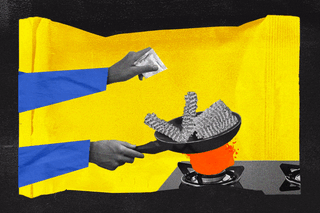
How Instant Noodles Became the Gateway to Cooking for Many Young Indians
“My first culinary foray was putting slices of chocolate and cinnamon into Maggi; it was disgusting but empowering.”

Apart from marking India’s first cricket World Cup victory, 1983 also witnessed the arrival of Maggi in the Indian market. Although noodles were part of Indians’ diets prior to this, Maggi revolutionized the way we approached the stringy carbs. “[What] ‘Xerox’ is for photocopiers, ‘Colgate’ is for toothpaste… ‘Maggi’ is for noodles,” an article from 2003 states.
In the process of capturing the collective imagination of millions of Indians through its hunger-inducing bright yellow-and-red ads on billboards, newspapers, and TV screens, the craze around Maggi also caused it to become something akin to a crash course in culinary skills for many Indians — leading teenagers and young adults alike into kitchens for the very first time. “The first time I ever made Maggi, I was 18 years old… It was the first time I was ever attempting any kind of cooking. Maggi seemed like the easiest option; no surprises with what you would get, ready in two minutes, and how wrong could one really go with boiling noodles in water?” notes Shrutika, 28.
Soon after the ’80s, perhaps to replicate Maggi’s success, other brands started selling their own instant-noodle variants, like Nissin’s Top Ramen and ITC’s Yippee. What unites these products is their chameleon-like ability to shine through a myriad of flavors, making them the perfect dish for ‘Kitchen 101.’ “…Maggi [has] created a generation of experimental cooks,” as Shirin Mehrotra wrote in The Juggernaut.
In her “Ode to Maggi” in 2018, Mihika Mirchandani wrote for The Swaddle: “If you eavesdrop on teenage chit-chat, you might hear kids boasting about how many variations of Maggi they can ‘cook.’ You’re probably thinking: how much can you do with instant noodles? Turns out, if you’re a ravenous teenager with (dubious) culinary talent, there’s no end to the number of Maggi-licious meals you can churn out: cheese Maggi, chicken sausage Maggi, scrambled eggs on Maggi, to name a few. I’ve even known people to put a serving of Maggi between two slices of toast with a layer of potato crisps and a slice of cheese.”
Instant noodles are, indeed, great culinary teachers, primarily because they allow vast room for exploration — not just of flavors, but also of the self. “By regularly cooking and experimenting with Maggi, I realized I became more mindful of the flavors I like. Like, I didn’t just eat whatever was given [anymore] but I was able to tell whether I wanted more salt, or different spices were required in a particular dish,” Lalitya, 23, says.
Related on The Swaddle:
How Much Can Food Help People Heal From Trauma?
Further, since instant noodles are designed in a way that makes it difficult to cook them ‘wrong,’ starting one’s culinary journey with them is accompanied by more than a few helpings of confidence. The noodle cakes also allow people to experience a sense of autonomy — helping them get more comfortable with their culinary ideas and imbuing them with a sense of self-reliance. Aria, 25, who first made Maggi at the age of seven, says, “I felt independent, and it was formative in helping me feel confident and trusting my intuition in the kitchen… The freestyling fostered intuition.”
Moreover, messing up the preparation of instant noodles doesn’t undo hours of laborious toil in the kitchen, and whipping up another steaming bowl from scratch rarely takes over 10 minutes. This allows one to emerge with a better sense of what works best for their taste buds and what absolutely does not. There are, thus, few teachers as kind as instant noodles when it comes to molding culinary intuitions.
Evidently, then, instant noodles didn’t just serve as a gateway to cooking for countless Indians, but in a way, also empowered them. “My first culinary foray was putting slices of chocolate and cinnamon into Maggi; it was disgusting but empowering,” says Pandu*, 23.
It is no wonder, then, that in 2015, BBC termed Maggi an “iconic Indian snack.” Over the years, Maggi has become so embedded into India’s socio-cultural fabric that cooking it even helps some feel a sense of connection with their cultural heritage. “I never cooked [Maggi] simply, but with some variation of spices, onion, tomato, among other things… It helped me develop an identity with my unique Rajasthani taste,” Aria notes. “Growing up in New York, I felt so removed from other forms of Indian food and culture… But from a young age, Maggi allowed me to be an active participant in the culture and not just a recipient.”
But that’s not the only reason why the noodles assumed the status of a pan-Indian snack with ease. Maggi’s affordability also factored into its appeal – cutting across different socio-economic groups, and attracting young Indians from metropolitan cities and smaller towns alike. Furthermore, for many students like Shrutika, who left the comfort of their homes for the first time — for work or education — instant noodles became sources of piping hot nostalgia in 10-rupee-packets. “Eating out all the time was not within my student budget, and instant noodles became my comfort food. Easy, quick, tasty,” she recalls, adding how “it almost felt like a taste of home.” A humble bowl of Maggi allowed her to incorporate the flavors she associated with home food — creating, for her, a transient but homely oasis away from home.
Related on The Swaddle:
For People With Poor Impulse Control, Instant Food Delivery Apps Can Kickstart Disordered Eating
Although instant noodles aren’t unique to India, what is striking about their appeal, here, is just how easily they can accommodate the flavors from cuisines in different parts of a country that is known for its diversity. That is, perhaps, also why newer variations of instant noodles — that boasted of more specific inherent flavors — never became as entrenched into the country’s cultural milieu as the classic Masala Maggi and Top Ramen Curry did. Over the years, Maggi, too, has tried launching different flavors in India — Tomato, Sweet ‘n Sour, Capsica, Chatpata, and the Hot Heads range — only to discontinue them soon after. They lacked Maggi Masala’s typical malleability to different spices and flavors, which is a huge part of its appeal for amateur, experimental cooks.
“Maggi has managed to travel the length and breadth of the country. It’s the magic of Maggi – as much as the masala flavor – that wins over taste buds all across a country with disparate palates,” Mirchandani had noted.
It’s true that the noodles’ legacy in the country has been tainted by Maggi’s 2015 ban, but its place in the cultural history of India — and the hearts of Indians — remains unrivaled. Today, for many millennial Indians whose advent into adulthood has been marred by a mental health crisis, climate change, a global pandemic, and financial insecurity, Maggi has become a coping mechanism of sorts. The nostalgia it invokes can induce a “reminiscence bump” that helps people travel back to simpler, happier times. Especially so, since smell, which is an integral part of taste, is known to evoke strong memories. It is, perhaps, this nostalgic aroma of Maggi that prevented us from severing the metaphorical umbilical cord we share with it — making us rely on it as a source of warmth and comfort that happens to be packaged as an easy-to-cook food.
While the pandemic may have taught people how to sustain themselves through their culinary skills if push comes to shove, it was Maggi that made many young Indians uninitiated in the art of cooking, aware that they, too, could wield culinary prowess. To an extent, instant noodles have become a rite of passage in the country – one that is recognized not just by millennials and Gen-Z’ers, but also by their parents, many of whom grew up before India witnessed its “instant noodles revolution.” As Nehal, 24, says, “I started making tea [only] after I learned to make Maggi. It was a sense of a start, you know? Even [my] parents thought that this is how you start learning.”
*Name concealed to protect identity.
Devrupa Rakshit is an Associate Editor at The Swaddle. She is a lawyer by education, a poet by accident, a painter by shaukh, and autistic by birth. You can find her on Instagram @devruparakshit.
Related


What Are the Ethics of Fashion Magazines Using War‑Zones as a Backdrop?
